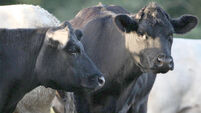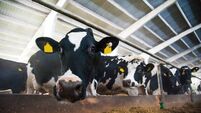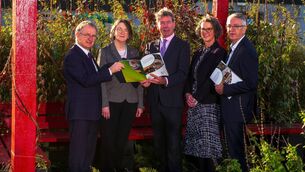Report recommends dairy sector overhaul
Another report is due calling for a radical overhaul with the usual red alert warning that failure to comply will see the Irish dairy sector fall further behind.
At issue here is the leaked ICOS report carried out by management consultants Prospectus.
They have recommended the creation of a new super co-op to handle 70% of all of the country's milk pool.
At this point Kerry, Glanbia, and Dairygold combined account for 70% of the total and if that aim is to be satisfied then the major players will indeed all have to go back to the drawing board to see what they can come up with.
Again this report will confirm what has been known for decades: that the industry needs to rationalise further.
So far it has failed in that endeavour, but it would be totally wrong to conclude that the sector has stood still.
In reality ever since membership of the Common Market as it was known back then, started to loom in the early 1970s the dairy sector started to gear up for the impending bonanza that became a reality once we became fully signed up members in January 1973.
In another irony or contradiction of the time Kerry Group which did not form out of a very strong co-op tradition was the one that adapted quickest and fastest than the rest.
By the time the EU beckoned several key dairy companies had been set up, predominantly in the south and south east of the country.
That was a pretty dynamic response at the time and as we joined the EU Irish dairy farmers were represented by an impressive array of dairy coops ranging from Mitchelstown in North Cork to Lough Egish in Monaghan and North Connacht Farmers Co-op in the West with several others in between ranging from Waterford to Avonmore.
To varying degrees all of these were successful in their own right.
But global pressures and some wrong investment strategies resulted in Waterford and Avonmore to form Glanbia.
Kerry recently took over Golden Vale while Dairygold was formed out of the merger of Ballyclough and Mitchelstown. In between several of the dairy giants came to the stock market, with varying degrees of success.
That move was motivated by the quest for expansion with the UK market the key target for those interested in expanding their interests.
There was a time when the Irish dairy sector outstripped the UK dairy sector in terms of its acquisitiveness and it looked as if Waterford, Avonmore and Golden Vale were set to make a major mark as players in the UK dairy sector.
Good EU subsidies and fairly dynamic management teams allowed the Plcs to grow at a fairly dynamic pace, and the mood was upbeat for a good few years after the various dairy coops came to the market.
The struggles that subsequently followed have been well documented, and there is little point in dwelling on what might have been, if the various players had been more successful.
In a recent interview Kerry boss Hugh Friel summed up the reality facing the Irish dairy sector as the EU gears up for major enlargement.
We have to face up to the competitive question as the market becomes price and not subsidy driven.
The efficiency of Irish farmers has long been an issue that still has to be addressed.
Either we become low cost producers or else we have to add sufficient value to the basic raw material of milk that they can be sold profitably anywhere in the world.
These are issues coming down the track faster than many expected.
The EU is changing beyond recognition and indeed so has Irish agriculture which now has more part time than full time farmers.










